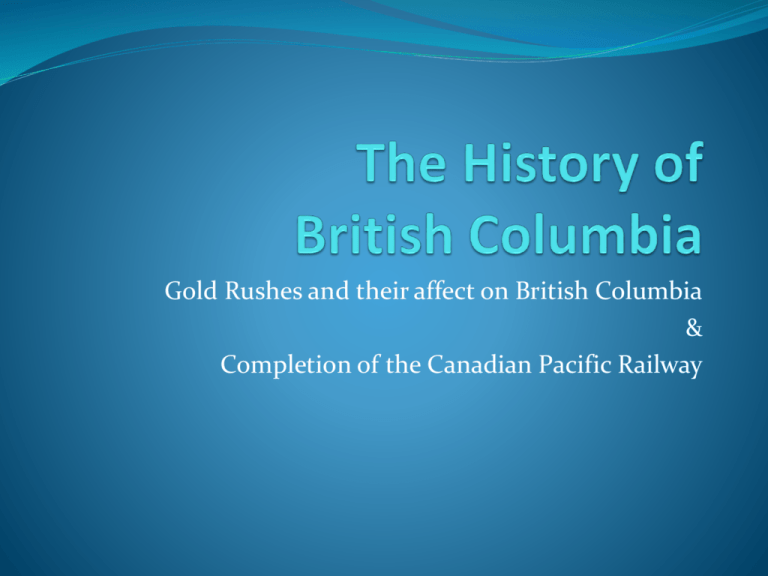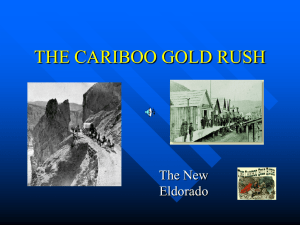Canadian Pacific Railway Company
advertisement

Gold Rushes and their affect on British Columbia & Completion of the Canadian Pacific Railway The various Gold Rushes and their affect on British Columbia Gold Rush Overview The first gold discovery was made in 1859 at Horsefly Creek The actual rush did not begin until 1861, when these discoveries were widely publicized Several towns grew up, the most famous of these being Barkerville The most famous of the gold rushes but it wasn’t the only one Affects on the New British Columbia Cited as the reason for the creation of the Colony of British Columbia Over 20,000 Americans from California came looking for gold Americans quickly out numbered the small British and Canadian settler populations UBC forts such as fort Langley created large profits in selling supplies to the prospectors New Westminster “The Royal City” In 1859 was selected by Queen Victoria as the first capital of the new Colony of BC One year latter became the first city in BC to have an elected government Was a major outfitting point for Gold prospectors Was replaced by Victoria in 1866 when the two colonies merged In 1878, the Government of Canada the first federal penitentiary west of Manitoba Chinatown was one of the biggest The B.C. Penitentiary being constructed circa 1877 Fraser Canyon Gold Rush Occurred in 1858 after gold was discovered on the Thompson River A few miles upstream present-day Lytton. Within a month 30,000 men from California had descended upon Victoria, which only had a population of about 500 By the fall, most had failed to stake claims, or failed because of the summer's high water on the river left It caused a disruption of balance between the HBC and the Natives The New Eldorado: "A Complete View of the Newly Discovered Goldfields" Big Bend Gold Rush Occurred on the upper Columbia River in the Late 1860s was a spin-off of the Fraser Canyon Gold Rush Many American Gold Miners left the Fraser Canyon in search of gold Located just past the Death Rapids" of the Columbia, which had been the scene of horrendous tragedies twice, in 1817 and 1838 Rock Creek Gold Rush In 1859 two US soldiers cross the border to escape pursuing Natives and found gold only three miles into British territory on the banks of the Kettle River nowadays Grand Forks At its peak, an estimated 5,000 men were in the area Trouble broke out when the Queen’s Mining tax was being collected from the American and Chinese prospectors Queen Charlottes Gold Rush In March 1851 when a Haida man sold a 27 ounce nugget in Fort Victoria for 1,500 blankets UBC sent the ship Una to mine, the natives tried to take it all and eventually the gold was split evenly or $1,500 in gold ($60,000 in modern dollars) as the yield from three blasts but the ship crashed Ten American ships went up but came back with very little because of the Haida hostilities The Minor Gold Rushes 1859-1869 Blackfoot Gold Rush, 1859 Similkameen Gold Rush, 1861 Peace River Gold Rush, 1861 (a.k.a Finlay Gold Rush) Stikine Gold Rush, 1861 Shuswap Gold Rush Cherry Creek Gold Rush Omineca Gold Rush Wild Horse Creek Gold Rush Goldstream Gold Rush (Leechtown) Burnt Basin Gold Rush Whatcom Trail Several thousand Gold Seekers used this trail but there is not exact number Open defiance of the edict from the British Governor on Vancouver Island that access to the Fraser goldfields must be made from Victoria It demonstrated the colony's inability to prevent unregulated intrusion by US citizens Okanagan Trail Was an inland route to the Fraser Canyon Gold Rush The same route that the HBC fur brigades used because it followed the Columbia River Once again no accurate records were kept for how many used this route Fort Hope Built by the Hudson's Bay Co in 1848 there were 300 people living there when a Townsite was laid out American steamers were running passenger and freight service up the Fraser from Victoria to Hope The start of steamboat service to Yale the next year, killed the Whatcom trail Early photo of Fort Hope circa 1860 two years after the initial rush on the lower Fraser River gold bars Yale "the wickedest little settlement in British Columbia" An unincorporated though historically very important small town Founded in 1848 by the HBC Begbie talked to the American miners and took control of matters that threatened the rule of the Crown over the Mainland Is located on the Fraser River and is considered to be the dividing point between the coast and the interior The best location for the start of the Cariboo Wagon Road Front Street, Yale, British Columbia circa 1882 Cariboo Road Initiated in 1862 by the colonial Governor of BC James Douglas Stretched from Fort Yale to Barkerville through extremely hazardous canyon territory in the Interior of B.C Considered to be an Engineering Feat Was a reaction to a high concentration of gold in the Cariboo region Based along an old dangerous and narrow Mule trail Thought to be more viable and safe form of transportation to the gold mining settlements Route of the Cariboo Road in red. Steamboat travel in blue; dotted lines are alternate routes or routes to other goldfields. Cariboo Road Costs Cost nearly $250,000 and left a standing debt of £112,780 after its completion One of many projects that forced its amalgamation with the Vancouver Island Colony Transportation of over six and a half million dollars worth of gold Originally Douglas wanted to extend the road to Alberta but this plan was abandoned when he retired A portion of the Cariboo Road just above Yale, circa 1867–1868 The Cariboo Road at Soda Creek Barkerville In 1862 when William "Billy" Barker, an English boatman, made a huge strike at William's Creek The biggest Gold strike in BC Eventually 1100 kilograms of gold was found Once the largest city north of San Francisco and west of Chicago Was the northern terminus for the Cariboo Road Prices remained high until the Road Barkerville (cont’d) More than a mining town because it had several general stores and boarding houses, a drugstore that also sold newspapers and cigars, a barbershop Was destroyed by a fire but was quickly rebuilt within six weeks Chinese were an important part of Barkerville life for almost a hundred years It would begin to dwindle as the gold dried up and in 1958 the provincial Government turned it into a historic site Barkerville (1865) William (Billy) Barker Worked in the Canals in England as a waterman before rail made them obsolete Went to California his claim became the most prominent of the Cariboo goldfield towns Had a lot of money but died in poverty His simple grave stone is found in Victoria The Early Years of Matthew Baillie Begbie “The Hanging Jugde” From 1858 - 1894 he was the main judge in British Columbia When he reached the age of 31 Degree from Peterhouse at the University of Cambridge, where he studied mathematics and the classics Got his Law degree from Cambridge and opened his own Law firm in London He also belonged to dining societies, playing chess, rowing, and tennis Life in British Columbia Reached Fort Victoria on November 16, 1858, and was sworn into office in Fort Langley on November 19 Traveled throughout British Columbia, on foot and later on horseback administering justice Spoke several languages was able to conduct trials in several aboriginal languages without the use of an interpreter He only hung 52 out of 72 of his clients because that was the only option under British Law His funeral procession is said to have been unprecedented because it mark the passing of a man regarded as British Columbia's first citizen Sir Matthew Baillie Begbie Birth of British Columbia Led to the declaration of the Colony of British Columbia Governor Douglas placed restrictions on immigration to the new British colony All travel had to go through Victoria Overland routes to the goldfields could not be controlled Cariboo Gold Rush Review Questions What happened during the Fraser Canyon Gold Rush? Why did the American Gold Prospectors worried the British Government? List and explain at least three facts about the Cariboo Road From your Horizons Textbook Read Pg. 222 - 224 Answer # 1 - 4 (Above Activities Section) Answer # 2, 3 & 5 (Bottom Activities Section) Key Knowledge Points Canadian Pacific Railway Company The Pacific Scandal Alexander Mackenzie The National Policy The CPR Syndicate Money Troubles The Northwest Uprising and the CPR Who will build the railway? When BC joined Confederation in 1871, the Canadian Government promised to build a railway to the West coast within 10 years John A MacDonald had no idea what route the railway would take or how much it would cost. He only knew that he had a dream to make a country that stretched from sea to sea Who will build the railway? MacDonald knew that the government did not have the money to complete the project on their own. He decided to offer incentives to wealthy businessmen and owners of other railways to convince them to finance to construction of the railway. Who will build the railway? Jay Cook Jay Cook was an American businessman, realized that the Canadian West had lots of potential in terms of making money Sir Hugh Allen Sir Hugh Allen was the only Canadian with enough money to invest in the railway. He had made his money in shipping, manufacturing and railways in eastern Canada Who will build the Railway? Jay Cook and Sir Hugh Allen joined forces in 1871 and created the Canadian Pacific Railway Company This company seemed Canadian, but it was actually controlled by Cook The Pacific Scandal In the summer of 1872 John A MacDonald (leader of the Conservatives) called an election. During the election the Conservatives realized that they needed more money for their campaign. MacDonald asked Hugh Allan if he could provide money for the campaign. In exchange, MacDonald promised him a guaranteed railway contract. Why might some people have a problem with this??? The Pacific Scandal The Conservatives won the 1872 election just barely, but in 1873, this agreement between MacDonald and Allan was made public. Because of this deal, the public believed that MacDonald had bought votes. He was forced to resign from office. Alexander Mackenzie and the Railway In 1873, when MacDonald was forced to resign, Alexander Mackenzie led the Liberals to power. He thought that the railway was a waste of time and money. However, he had to continue with the promises that MacDonald had made while he was in power. Alexander Mackenzie and the Railway In order to make it look like he was doing something about the railway, Mackenzie decided to allow the land survey to continue. This was an easy and inexpensive way to stall without actually spending money building the railway. The Route There were many different routes proposed, none of which were actually used in the end. The final route was through Calgary to Kamloops. The National Policy John A MacDonald was out of office for 5 years from 1873- 1878. In 1876, he developed a National Policy, which became the basis for his election platform in 1878. Voters agreed with his vision and elected him back into office with a large majority. The National Policy The National Policy had 3 parts: 1. A system of protective tariffs (taxes) 2. Increased immigration 3. The building of the CPR The CPR Syndicate 1) George Stephen – President of the Bank of Montreal 2) Donald Smith – businessman with the Hudson’s Bay Company 3) James J. Hill – businessman in various fields and railway owner The CPR Syndicate In 1880, MacDonald made the group an offer: If the CPR Syndicate built the railway in 10 years, they would get: 1. 2. 3. $25 million in cash A land grant of 25 million acres A business monopoly west of Lake Superior for 20 years. What do you think the CPR Syndicate could do with this monopoly??? The CPR Syndicate The CPR Syndicate immediately changed the route of the railway. Construction began in the spring of 1881 but was very slow. By the end of the year, they had only built 250 kilometers of rail. The CPR Syndicate decided to hire William Van Horne as their general manager. Van Horne had been very successful in his past business projects and in building other railways. Under his control, 800 kilometers of rail was built in 1882 and another 800 kilometers were built in 1883. William Van Horne Was a 38 year old general manager of a smaller railway. Was very determined and saw no task as being impossible to achieve. Made the CPR an efficient railway company. $$$ Troubles By the end of 1883, the company was running out of money and the most costly section of the railway (in British Columbia) had not been built yet. In 1884, the Canadian government passed a bill that provided another $22.5 million for the railway. Van Horne cut expenses but it was still not enough. In what ways do you think expenses were cut??? Cutting Costs and Corners Found Cheap Labour Cut corners on the construction of bridges $$$ Troubles Many workers were brought to Canada from China. The living and working conditions were terrible and many people died while building the railway. The CPR and the Northwest Uprising When the Northwest Uprising broke out in 1885, the Canadian government needed to move troops to Saskatchewan quickly. Thanks to the CPR, the troops made it to the Prairies in 10 days- very fast! This proved to the people of Canada that the railway was very important for protection and made it possible for MacDonald to secure more money for building from the public. The CPR was completed in November of 1885 - 5 years ahead of schedule!




